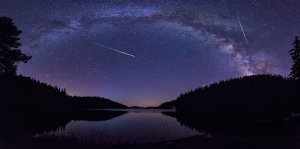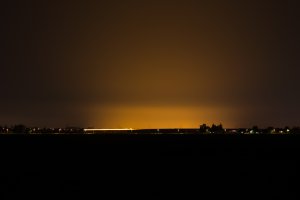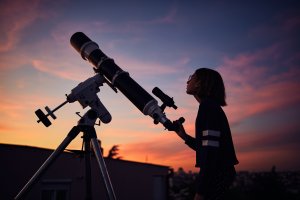Stargazing – Perseids Meteor Shower and Climate Change
August 13, 2024
By: Samantha Volz, Park Interpreter
A Star-Studded Evening
 It’s a cloudless evening in mid-August as you lay on the grass peering up at the darkened sky. When suddenly, a flash of light makes its way across the horizon! Bright white streaks dotting the night sky, creating a beautiful display of “shooting stars” right before your eyes. You lay witness to one of the most prolific and beloved meteor showers throughout the Northern Hemisphere, the Perseids! From mid-July to the end of August, the Perseid Meteor Shower provides beautiful displays of light and color dancing throughout the evening skies. Meteor showers are one of many celestial phenomena that we are capable of viewing from Earth, and they happen around the same time every year. How is this possible? How can we predict when and where a meteor shower will happen?
It’s a cloudless evening in mid-August as you lay on the grass peering up at the darkened sky. When suddenly, a flash of light makes its way across the horizon! Bright white streaks dotting the night sky, creating a beautiful display of “shooting stars” right before your eyes. You lay witness to one of the most prolific and beloved meteor showers throughout the Northern Hemisphere, the Perseids! From mid-July to the end of August, the Perseid Meteor Shower provides beautiful displays of light and color dancing throughout the evening skies. Meteor showers are one of many celestial phenomena that we are capable of viewing from Earth, and they happen around the same time every year. How is this possible? How can we predict when and where a meteor shower will happen?
Star Light, Star Bright
 Meteor showers are created through several different circumstances. Most commonly, they originate from the broken bits and pieces of comets and asteroids – large bodies made of ice and rock. These broken off pieces of asteroids and comets are moving through space, sometimes crashing into moons, planets and even our own planet Earth! When one of these pieces crash into Earth’s surface, it is known as a meteorite, but sometimes they don’t crash, and instead simply pass through Earth’s atmosphere as a meteor.
Meteor showers are created through several different circumstances. Most commonly, they originate from the broken bits and pieces of comets and asteroids – large bodies made of ice and rock. These broken off pieces of asteroids and comets are moving through space, sometimes crashing into moons, planets and even our own planet Earth! When one of these pieces crash into Earth’s surface, it is known as a meteorite, but sometimes they don’t crash, and instead simply pass through Earth’s atmosphere as a meteor.
Earth’s atmosphere is so hot that the icy particles, dust, and rock cast off from a passing comet (aka meteors) burn up in the process. This burning is what creates the colorful streaks of light across the night sky! Depending on the comet’s composition, or what it’s made of, these streaks of light can be a multitude of colors – blue, green, yellow, orange, red and white.
The Perseid meteor shower originated from Comet Swift-Tuttle, first identified in 1862. Each year the remaining debris from Comet Swift-Tuttle makes its way around the Earth, spreading its fiery beauty across the Northern Hemisphere.
Seeing Through the Haze
 As the years go by you may start to notice that you may have more difficulty seeing the brilliant colors of the Perseids Meteor Shower and stargazing in general has become more of a challenge. These challenges can be due in part to climate change and its effect on air quality and sky visibility. The more particulates, water, and pollution in the air, the more difficult it becomes to see distant objects in the sky.
As the years go by you may start to notice that you may have more difficulty seeing the brilliant colors of the Perseids Meteor Shower and stargazing in general has become more of a challenge. These challenges can be due in part to climate change and its effect on air quality and sky visibility. The more particulates, water, and pollution in the air, the more difficult it becomes to see distant objects in the sky.
The Earth’s ozone has thickened with additional particles taking up space and further warming our planet. The ground level atmosphere is filled with light and air pollution, causing a decrease in visibility of the night sky. More wildfires are being reported each year, creating a haze that spreads and sticks to the air for weeks. A warmer atmosphere can increase the rate at which water is evaporating, leading to added water content entering the air. All these factors together can create fewer clear evenings to view not only the Perseids but stars and other celestial objects. While we don’t know the future of stargazing, atmospheric trends and how climate change may affect those things, there is still much to look forward to and ways to get involved.
When You Wish Upon a Star
 One of the easiest ways to help “clear the air” is to reduce your use of light at night. Light pollution, which is the excessive or inappropriate use of artificial light can have detrimental effects on stargazing, wildlife behavior and even human health. Unnatural light can disrupt humans’ circadian rhythms as well as movements by migratory birds. How can you reduce your light pollution? Start by simply turning off unnecessary lights at night! Close your blinds when lights are on, use high efficiency bulbs outdoors and point towards the ground, rather than the sky. Don’t just stop at light pollution, reducing air pollution can also help. Driving less, limit your backyard fires, use electric power where applicable, plant trees, and switch to high efficiency appliances and lawn care equipment.
One of the easiest ways to help “clear the air” is to reduce your use of light at night. Light pollution, which is the excessive or inappropriate use of artificial light can have detrimental effects on stargazing, wildlife behavior and even human health. Unnatural light can disrupt humans’ circadian rhythms as well as movements by migratory birds. How can you reduce your light pollution? Start by simply turning off unnecessary lights at night! Close your blinds when lights are on, use high efficiency bulbs outdoors and point towards the ground, rather than the sky. Don’t just stop at light pollution, reducing air pollution can also help. Driving less, limit your backyard fires, use electric power where applicable, plant trees, and switch to high efficiency appliances and lawn care equipment.
There are many ways to be an active clean air champion. Sometimes something as simple as participating in community science efforts can help scientists collect and analyze data that can have long-term impacts on the environment. A great place to start getting involved in community science is https://scistarter.org/darksky where you can find links to several projects to “help scientists better understand how light impacts our view of the night sky.” While clean air and skies may seem like a far-off goal, there’s no better time than the present to work towards a solution.
“Keep your eyes on the stars, and your feet on the ground.” – Theodore Roosevelt
